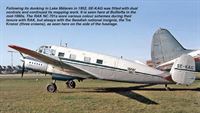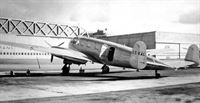Фотографии
-
Регистрационный номер: SE-KAL [3] Seen here at Arlanda in a natural-metal finish and dayglo bands on the outer wing sections and tailplane, SE-KAL is currently undergoing restoration by the Arlanda Civil Aircraft Collection. Its glazed nose gives it the appearance of a pocket-sized Heinkel He 111, the “goldfish bowl” being a popular configuration in the 1930s.
Самолёты на фотографии: Siebel Si.204 - Германия - 1941
-
Регистрационный номер: SE-KAG [2] Following its dunking in Lake Malaren in 1952, SE-KAG was fitted with dual controls and continued its mapping work. It is seen here at Bulltofta in the mid-1960s. The RAK NC.701 s wore various colour schemes during their tenure with RAK, but always with the Swedish national insignia, the Tre Kronor (three crowns), as seen here on the side of the fuselage.
Самолёты на фотографии: Siebel Si.204 - Германия - 1941
-
Регистрационный номер: SE-KAE [2] Nord NC.701 SE-KAE, one of the first two to arrive in Sweden, captured over a typical Swedish landscape.
Самолёты на фотографии: Siebel Si.204 - Германия - 1941
-
Регистрационный номер: SE-KAE [2] Nord NC.701 SE-KAE in the 1960s, during its tenure with Sweden’s National Mapping Department. The creation of topographical and economic maps had been a military responsibility until 1937, when it was placed under civil authority. Sweden’s survey work is now undertaken by Lantmateriet, the National Surveying Authority.
Самолёты на фотографии: Siebel Si.204 - Германия - 1941
-
Регистрационный номер: SE-KAL [3] Showing the type's long tapered wings to good advantage, SE-KAL is seen here awaiting its next sortie at Stockholm’s Bromma Airport, opposite the hangar of pioneering Swedish helicopter company Ostermans. The third NC.701 to be taken on strength by RAK, the former French Air Force aircraft was delivered to Sweden in 1963.
Самолёты на фотографии: Siebel Si.204 - Германия - 1941
-
A poor-quality but rare photograph of the sole Si 204 to visit Sweden, still in its Luftwaffe markings. The type made its first flight, in the form of the “stepped-nose” Si 204A, at the end of May 1941. The Si 204D, with its distinctive glazed nose, made its maiden flight the following year.
Самолёты на фотографии: Siebel Si.204 - Германия - 1941
-
Регистрационный номер: SE-BPW Siebel Si 204D SE-BPW was the only German-built example of the type to be put on the Swedish register, having been flown to Kallinge by war refugees in April 1945. The aircraft eventually returned to Germany as D-IBAB, and was broken up at Hamburg some time in the 1960s.
Самолёты на фотографии: Siebel Si.204 - Германия - 1941
-
Регистрационный номер: SE-KAL [3] Another view of SE-KAL at Bromma. The type was of conventional construction, with an all-metal structure, a single-spar wing and a dihedral led tailplane of adjustable incidence with twin fins and rudders. The mainwheels retracted backwards into the engine nacelles.
Самолёты на фотографии: Siebel Si.204 - Германия - 1941
-
Регистрационный номер: SE-KAG [2] A rather waterlogged SE-KAG after its unmanned ditching in Lake Malaren, a freshwater lake directly to the west of Stockholm. Just visible in this poor-quality photograph are the black marks left on the cabin roof by the shoes of the pilot, Rudolf Bryant-Meisner, who baled out of the open hatch in the roof of the glazed cockpit.
Самолёты на фотографии: Siebel Si.204 - Германия - 1941
-
Nord NC.701 Martinet
Самолёты на фотографии: Siebel Si.204 - Германия - 1941
Статьи
- -
- A.Delalande, T.Cooper - An eye for an eye
- C.Goss - Last days of the Condor
- E.Wild - Hijack hijinks!
- G.Baughen - A Brief History of the Future
- J.Forsgren - The flying darkroom
- J.Matos - Nao obrigado!
- M.Bearman - The Whirlwind becalmed
- M.Wickstead - A sky full of frontiers
- M.Willis - How to build a Sea Hawk
- N.Stroud - Fire in the belly
- N.Stroud - Heathrow. The Roaring Forties /The John Stroud Archive/
- P.Davidson - Off the Beaten Track...
- P.Jarrett - Lost & Found
- P.Jarrett - The Blue Falcon
- R.Riding - Three deadly minutes









